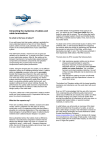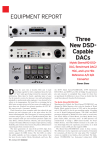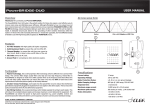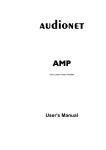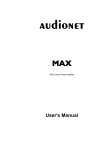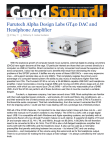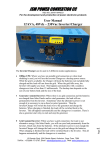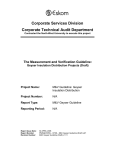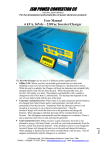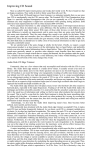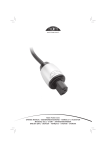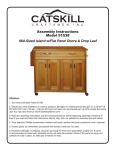Download Unravelling the mysteries of your hi-fi / home theatre
Transcript
Unravelling the mysteries of your hi-fi / home theatre system mains power supply (revised Feb 2012) Jeandré Botha (M. Eng, MBL) 1. Why should I be concerned about my system’s mains supply? We live in an invisible sea of electromagnetic energy, caused by the electronics we own, radio stations, the earth's movement through space, even the sun's radiations. Electromagnetic Interference (EMI), Radio-Frequency Interference (RFI) and Electrostatic Interference (ESI) are on the rise with mobile phones, wireless LAN's, digital radio and digital satellite TV broadcasting, all attacking your mains. The arrival of 3G phones with their “always live” radio connections and wireless broadband internet connections, introduces a hideous soup of RFI that your mains just love to transmit into your audio equipment. All these signals, when summed together in your living room, are called EMI/RFI (or simply unwanted/spurious electromagnetic signals or noise). Ideally, our AC power lines should contain nothing but absolutely clean 50 Hz, but we don't live in an ideal world and our power supply lines are in fact massively contaminated. In any city, the degree of grid pollution is both large and ever growing. EMI is conducted from audio components or appliances in your home via the AC power grid. For example, a humming refrigerator adds a lot of noise/spurious signals on you AC power lines. RFI is radiated by your system’s components and cables and received from radio signals/noise in the environment (which is much worse in urban areas due to an accumulation of RF sources, such as cell phones). It's all noise and has varying negative affects on audio/video signals. Household noise shown as accumulative series – courtesy of Ecosse Reference cables What you are fighting in you mains system is not just one problem, but a number of problems, all of which have the potential to affect the sound (and video quality) of your system: The first problem is earthing, or rather a lack thereof. The next problem is EMI and RFI as explained above. As such, dealing with your system mains supply should be considered fundamental. Copyright AVCables cc --- Page 1 Thankfully, electromagnetic effects such as capacitance, inductance and resistance can be minimised by the use of high quality dielectrics. Components and cables can be designed to reject RFI noise and proper filtering of your AC power and signal cables can reduce EMI conducted noise; and the results can be heard if you have quality equipment. (PS: There is also the problem of electromagnetic interaction between components across the mains – but hey, there's only 24 hours in a day for this stuff…so read on…and quickly!) 2. AC mains noise: The facts Have you ever experienced days/nights when your system just isn't sounding (or picture looking) as good as you remember it? Something is wrong; it's lifeless and uninvolving. What's going on? It's not your imagination. It's because your AV components are designed to operate consistently with 240 Volts of AC power, but they rarely receive that amount from your wall outlet. The power is constantly changing, and that’s bad for home audio/cinema. There are home, your local electricity provider changes in consumer demand. The many reasons for this: Outside your How can you tell you’re a victim (yep, ESKOM) is reacting to constant higher the common demand in your community the less power coming of polluted AC power? Listen and into your home. Once inside your home, the effect is made even look for these symptoms: Flat, worse: Household appliances such as hair-dryers (the worst), washing computer equipment, etc. compound hard, grainy high frequencies, a becomes severely distorted by other thick and bloated midrange, fat spikes and sags, high frequency uncontrolled bass…. machines, vacuum cleaner, freezers, the problem. The AC power also factors such as ground noise, voltage power supply noise from other components in your own system, plus radiated high frequency digital noise from processors and digital interconnects. There are also distortion products at the top and bottom of the AC waveform created by switch-mode power supplies in electronic devices on the same circuit. Additionally, you’re never alone; your residential AC mains supply is shared with other apartments, homes, and businesses on the same utility transformer. Because you're A/V components have to compensate in real time to keep up (and down) with changing voltage, they end up doing much more work, and are often strained, to accomplish the tasks they were designed for. This can result in dramatically compromised system performance, not to mention shortened component life. The problems are numerous. How can you tell you’re a victim of polluted AC power? Listen and look for these symptoms: Flat, hard, grainy high frequencies, a thick and bloated midrange, fat, uncontrolled bass, and loss of air and soundstage stability. On video displays the picture resolution is less than sharp, with “ghosting”, colour shift, “snow”, or vertical and horizontal lines. If this looks and sound familiar, you need to clean up your AC power! Copyright AVCables cc --- Page 2 2.1 Video degradation that you can see Your TV monitor suffers visibly when AC power is unstable. Unfortunately, you may only realise this once you have installed a proper power filter and power cabling. When you see the difference you'll know. Regardless of which type or technology of TV display you own, there's a power supply inside it that feeds the monitor with the electrical energy to display pictures at your chosen settings. When your AC wall outlet supplies less than the required volts of AC power, the power supply in your TV monitor has to work correspondingly harder to produce pictures at these levels. The extra effort ends up being clearly perceivable as subtle, and sometimes not-so-subtle, picture artefacts, such as flickering and noise, as well as an overall loss of brightness, contrast, colour and sharpness. In CRT-based projectors, this same problem will actually cause the picture to lose focus. When the power supply works harder, it burns hotter, which then heats up the housings for the picture tubes. When heated, the tubes drift out of convergence and focus, with the result being a fuzzier picture. 2.2 Audio Degradation That You Can Hear The same problem clearly affects the audio in your system. When a musical or sonic peak happens during a particular piece of music, the amplifier(s) may need as much as 10, 20 or even 30 times as much power for the brief moment of the peak. This amplifier "headroom" is what gives your music the room to "breathe," sonically speaking. When the amplifiers receive less your wall that they were work much harder in order to energy for continuous musical working overtime, there's less details contained reproduced. within This the problem, than the 240 Volts of power from It’s your system cables’ ability to reject designed to work with, they have to (or rather screen) its conductors from produce the constantly changing all this noise that pretty much determines how your system is going to perform! music (or movie soundtrack) signals. Because the amp is energy to reproduce all of the fine delicate audio signal being naturally, is compounded when the calls for a dramatic sonic peak. Typically for us audiophiles most noise occurs in the 5 to 80 kHz range - right slap bang in the middle of our audible extremes. Bastard! It’s your system cables’ ability to reject (or rather screen) its conductors from all this noise that pretty much determines how your system is going to perform! Copyright AVCables cc --- Page 3 3. How do I combat these problems? 3.1 The AC Power Conditioner All of the above-mentioned problems can be controlled with a well-designed AC power-line conditioner and screened power cabling. Firstly, nearly all conditioners filter the incoming AC line to remove the high-frequency garbage generated by factories, neighbours, and your own household appliances. Second, some filters isolate the components from each other with small isolation transformers on some of the conditioner’s AC outlets. These transformers “break” the physical connection between components, preventing noise from travelling from one component to the other. The isolated outputs are often marked “digital” for plugging in digital components, preventing a digital processor from polluting the AC supplying the preamplifier, for example. Third, a good line conditioner will reduce the amount of noise coupled to signal ground. Finally, AC line conditioners can protect equipment from voltage spikes, lightning strikes, and surges in the power-supply voltage. Not all AC line conditioners offers all the mentioned functions—conditioners vary in their design principles, with some addressing one problem but not another. IMPORTANT: Cleaning up the power line for source components and preamplifiers is a different job from condition AC power for power amplifiers. Power amplifiers have very different AC requirements and thus must be treated differently. The description earlier of what a good line conditioner should do applies to source components and preamplifiers that draw very little current. Power amplifiers, however, draw enormous amounts of current from the wall. When the power amplifier delivers a significant amount of current to the loudspeaker—for a bass-drum whack, for example—the amplifier’s power-supply reservoir capacitors are drained to supply the current. The amplifier then draws a huge amount of instantaneous current from the wall outlet to replenish its filter capacitors. The amount of current pulled from the wall can be so great that the AC waveform distorts under the amplifier’s current draw; the waveform’s tops and bottoms are clipped off under the load. Any isolation transformer or active line conditioner in the AC path could limit the amplifier’s ability to draw current, and thus degrade the amplifier’s performance. (This is one of the reasons why Furutech does not design active power conditioners). Power-line filters that remove high-frequency noise can benefit a power amplifier, but transformers in series with the AC supply should be avoided! An AC line conditioner that works with power amplifiers must operate in parallel with the amplifier; that is, they drain noise to ground without putting any electrical components directly between the amplifier and the wall outlet. (This is also Furutech’s design philosophy for their AC line conditioners). Also note that AC line regulation DOES NOT improve the sound of an audio system; and can actually degrade it if the input voltage moves around the threshold at which a separate transformer tap kicks in. Moreover, most high-end audio equipment is designed to work within the tolerances of the AC supplied by the electrical company. This is why power conditioners for computers that incorporates line regulations should NOT be used for audio equipment. A power line conditioner can’t make poor audio equipment sound better; instead it merely provides the optimum AC environment for those components so that they can realise their full potentials. The sonic benefits of a good line Copyright AVCables cc --- Page 4 conditioner include “blacker” background, with less low-level grunge and noise. The music seems to emerge from a perfectly quite and black space, rather than a greyish background. The treble often becomes sweeter, less grainy, and more extended. Sound staging often improves, with greater transparency, tighter image focus, and a newfound soundstage depth. Midrange textures become more liquid, and the presentation has an ease and musicality not heard without the conditioner. If you haven't tried a power-line conditioner, you may not have heard your system at its best! There are various manufacturers offering power cabling and passive power filtering /distribution units, as well as active power conditioners. We at AVCables offer world-class power cabling and high-end power plugs and passive filtering/distribution units from Furutech. For more information, please contact the author or visit our website at www.avcables.co.za. This technical article was prepared by Jeandré Botha from AVCables CC. He may be contacted on 082 774 4831 or visit their website at www.avcables.co.za Copyright AVCables cc --- Page 5






